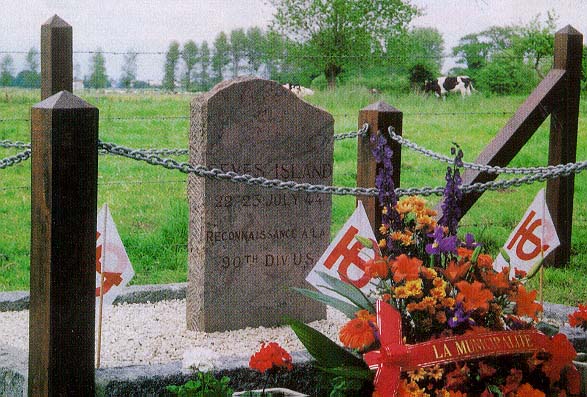

The battle for the "Seves River Island"

For the 90th Division, the battle of Montre Caste and Hill 122 had been a terrible and costly time. The road south to Periers would be no easier for the Tough Hombres. Between them and Periers was the German 6th Parachute Regiment. Although they had not parachuted into Normandy they had had gained their wings earlier in the war and had already fought in France, Crete, Russia, North Africa and Italy. Many of the lower ranks were young and this was for many of them the first time they had seen combat. By July 22nd elements of this Regiment were facing the 90th across a strip of land at St. German sur Seves, which lay on top of a low island. This was surrounded by swamps and creeks, and on the dry higher ground small fields bounded by hedges. This strip of land was only two miles long by half a mile wide. In July 1944 this hostile environment was made worse because of the heavy rains of the previous weeks. The 90th Division was tired after the long haul over Hill 122 and rested, had they have gone straight on the German would not have had the chance to prepare defensive positions. The Americans had planned a night attack on the German positions, but this idea was shelved because so many new personnel had been brought in to replace those who had been killed or injured during the battle for Hill 122. On July 22nd at 06:30 the attack began after the artillery had pounded the German positions. The 1st and 2nd battalions of the 358th advanced towards St Germain sur Seves from the north. The Germans had destroyed the bridge across the small river and the attack was to create a bridgehead so that engineers could construct a bridge so that tanks could be brought into the battle. They penetrated almost 250 yards, but without covering fire they were terribly exposed and two officers and seven men were killed, plus ten officers and one hundred and eighty men were injured. The Germans believing that they were only facing an expeditionary force counter attacked with one company of just thirty two men. The weather had improved and American fighters ruled the skies inflicting causalities to the Germans. In the early evening the Germans attacked the weaker right flank of the Americans, pushing them back. Both sides dug foxholes for the night.
The Germans brought up two MG 42 machine guns and positioned them with a field of fire covering the meadow into which they were sure the Americans must come next morning. The next morning was a dreary grey day, causing the air cover to be postponed. The Germans also brought up three tanks to help repulse the Americans and they attacked just after 07:00. Without observer aircraft the American artillery to the rear was blind and ineffective. The Germans attacked three times within a couple of hours, causing many causalities in the American lines. Eventually the 1st Battalion commander surrendered, although some men escaped to the rear and back to the American lines, although the MG 42’s caused many causalities in the G.I's. The Germans who were outnumbered were surprised at the number of Americans they had captured and their problem now was escorting the prisoners. They assigned one German to twenty five Americans and took them back to headquarters, over two hundred Americans had surrendered. The German Major treated both officers and enlisted men with chivalry, entertaining the officers in his farmhouse to afternoon tea. The German Major (Von der Heydte) received the news at 15:00 that several Americans were trying to help the dead and wounded Americans in the swamp area. Three US Army Chaplains Fr. James Esser (Catholic) Edgar Stohler (Salvation Army) and Captain Edgar Stohler ( Disciples of Christ) had decided to go into no mans land with white flags with red crosses on them to try and bring out the dead and wounded. The Germans impressed by their bravery had stopped shooting. The Americans followed suite and even the artillery fire stopped. A German captain went to the chaplains and told them that the General had been informed and had suggested a truce so that the wounded of both sides could be helped. It was reported that German soldiers actually told the American where to look to find injured G.I's. At one point both American and German medics worked on the same injured soldiers. This was not the first time that Von der Heydte had acted in this manner, he had also halted a battle earlier in the month, when he returned captured American medics to the 83rd Infantry, with a note to Major General Robert C Macon saying that he thought the American had greater need, and added that if the situation was reversed that he hoped the Americans would return the favour. During this truce a good number of injured Germans and Americans were also exchanged. The truce at St. German sur Seves lasted three hours and the island was finally taken on July 27th, and Major General Eugene Landrum of the 90th was replaced by Brigadier General Raymond S. Mclain, and from that point on the 90th Division came of age, and their fortunes changed. General Bradley calling them "one of the outstanding in the European Theatre". The German success at St. German sur Seves was to be their last success in Normandy and the only time Americans were forced to surrender. Evidence of the battle can still be seen in buildings and some of the older trees, look at the third photo.
The Germans brought up two MG 42 machine guns and positioned them with a field of fire covering the meadow into which they were sure the Americans must come next morning. The next morning was a dreary grey day, causing the air cover to be postponed. The Germans also brought up three tanks to help repulse the Americans and they attacked just after 07:00. Without observer aircraft the American artillery to the rear was blind and ineffective. The Germans attacked three times within a couple of hours, causing many causalities in the American lines. Eventually the 1st Battalion commander surrendered, although some men escaped to the rear and back to the American lines, although the MG 42’s caused many causalities in the G.I's. The Germans who were outnumbered were surprised at the number of Americans they had captured and their problem now was escorting the prisoners. They assigned one German to twenty five Americans and took them back to headquarters, over two hundred Americans had surrendered. The German Major treated both officers and enlisted men with chivalry, entertaining the officers in his farmhouse to afternoon tea. The German Major (Von der Heydte) received the news at 15:00 that several Americans were trying to help the dead and wounded Americans in the swamp area. Three US Army Chaplains Fr. James Esser (Catholic) Edgar Stohler (Salvation Army) and Captain Edgar Stohler ( Disciples of Christ) had decided to go into no mans land with white flags with red crosses on them to try and bring out the dead and wounded. The Germans impressed by their bravery had stopped shooting. The Americans followed suite and even the artillery fire stopped. A German captain went to the chaplains and told them that the General had been informed and had suggested a truce so that the wounded of both sides could be helped. It was reported that German soldiers actually told the American where to look to find injured G.I's. At one point both American and German medics worked on the same injured soldiers. This was not the first time that Von der Heydte had acted in this manner, he had also halted a battle earlier in the month, when he returned captured American medics to the 83rd Infantry, with a note to Major General Robert C Macon saying that he thought the American had greater need, and added that if the situation was reversed that he hoped the Americans would return the favour. During this truce a good number of injured Germans and Americans were also exchanged. The truce at St. German sur Seves lasted three hours and the island was finally taken on July 27th, and Major General Eugene Landrum of the 90th was replaced by Brigadier General Raymond S. Mclain, and from that point on the 90th Division came of age, and their fortunes changed. General Bradley calling them "one of the outstanding in the European Theatre". The German success at St. German sur Seves was to be their last success in Normandy and the only time Americans were forced to surrender. Evidence of the battle can still be seen in buildings and some of the older trees, look at the third photo.